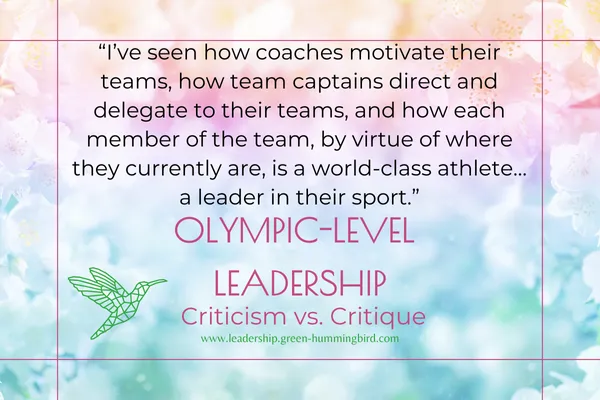
Olympic-Level Leadership: Criticism vs. Critique
I spent hours watching Olympics highlights last night. I’m not really a sportsball person, but there’s something about the fast-paced coverage of Olympic events that keeps my attention, even though I have no idea what the rules of each sport are.
There are a lot of leadership lessons to be found in the Olympic arena. I’ve seen how coaches motivate their teams, how team captains direct and delegate to their teams, and how each member of the team, by virtue of where they currently are, is a world-class athlete… a leader in their sport.
Of course, you also have the commentators, with various experiences with the sport, speaking over the events, explaining to us spectators the history of certain aspects of the event, what is momentous about what we are watching, and what could have been done better. As well as the judges, whose entire job is to notice the most miniscule differences between the competitors and score them accordingly.
All this got me thinking about the differences between Critiquing someone’s work and Criticizing them. One comes across as positive and helpful, and the other feels harsh and emotional. But if my own experience is any indication, most people do one while trying to get the benefits of the other. I thought I would clarify here, for the benefit of all.
Defining the Differences
When one criticizes, it is often emotional. Both for the Criticizer, and the Criticizee. Most of the time, especially in an office or home environment, the person criticizing is already upset about the repercussions of the other’s mistake. Chances are, the one who made the mistake is already upset about it, or at least recognizes the mistake and intends to do better the next time. In which case, emotional criticism will not help. If they are unaware of the mistake, being emotional, raising your voice, saying personal and mean things are not going to explain their mistake to them, but it will probably make them defensive and unlikely to listen to what the mistake was.
Even “constructive criticism” is often received negatively, because it is offered, rather than requested. It’s not a collaborative effort. It’s just one person telling the other what they can do better. It’s basically unsolicited advice. Let me know if you like this, but I never have.
In contrast, critiques are helpful. They are best approached with emotions in check, and with the mindset that you both want whatever it is to go better the next time. A critique emphasizes the belief that improvement is possible. Critiques are collaborative and kind.
I found this handy breakdown by Kevin Gerald

Clear is Kind
One of my two main pillars of leadership is to Be Kind. Unfortunately, most people think of “kind” as synonymous with “nice.” And while, yes, people treating others kindly can be considered “nice,” sometimes people take “nice” too far and the result is unkind. This especially happens a lot when trying to delegate work to people, and when trying to correct actions and behaviors.
Brené Brown goes in-depth on this issue in her bestselling book, Dare to Lead: Brave Work. Tough Conversations. Whole Hearts. One of her main mantras to come out of the book is “Clear is Kind.” Giving unclear instructions or feedback just leaves people in confusion as to what to do next.
I tend to give the direct instructions or feedback, I ask if there are any questions or comments, and I ask how they feel about it.
Handling Hearing Critique with RSD
Rejection Sensitivity Dysphoria makes hearing any kind of feedback regarding a mistake we made, or even how we could have done things better, a dramatic event. (By the way, I’m bringing this up because it tends to be comorbid with most neurodivergent conditions.)
We spend so much time and energy masking how we are different from everyone else that hearing how we made a mistake just hits different. It hurts more, and it can honestly feel like the end of everything, in the moment.
I have to admit that gracefully accepting critique is something that I am still working on, myself. But I got better at it when I had a leader whom I had grown to trust that she had my best interests in mind, and that she was doing it to help me grow as a person and a professional. This helped me to drop the defensiveness that I had learned to use in any kind of confrontational situation. When the defensiveness is dropped, it’s easier to hear what the actual issue is, rather than hearing that I’m the worst person ever and that I’m lucky the punishment isn’t worse (to paraphrase my brain).
Unfortunately, that trust can’t be put into every manager and boss out there. I learned the hard way that just because I could trust his predecessor, doesn’t mean I could trust him. Some people get the job not because of their leadership abilities and care for the team and the mission, but because they know the right people (although, these are the people who are more likely to come with criticism, rather than critique).
No matter who is coming to you, no matter if their approach is criticism or critique, keeping calm, focusing on the mission of the organization, and being honest are your best tactics when taking feedback.
Best Practices at Giving Critique as a Leader
For the love of all that is holy, please do not use the “shit sandwich” method when addressing a team member’s mistake! If you haven’t heard this term before, the “shit sandwich” method of giving someone feedback is where you compliment the person first, then tell them what they did wrong/need to work on, and then compliment them again. My last boss was very proud of the fact that this was how he addressed issues, but honestly, when it was directed at me, I saw it coming! I spent so much time stressing out about whatever my mistake was before it was presented that I didn’t hear the first set of compliments as anything but an intro. And the last set of compliments were when I was feeling like shit inside while trying to make my face look like I was fine so that my boss would go away faster and I could meltdown in private.
I’m a fan of being straightforward and honest. As Brené Brown says, “Clear is Kind.” I also appreciate how Ken Blanchard and Spencer Johnson recommend giving feedback in The New One Minute Manager. They say, “If you are first tough on the behavior, and then supportive of the person, it works better.” They suggest using one-minute redirects, instead of critique, criticism, feedback, or whatever it is. Everyone makes mistakes sometimes, and as leaders, we need to be able to use those mistakes to figure out where things went wrong, and improve on the process to avoid those mistakes in the future. Do this by (bold is from the book, everything else is my elaboration or take):
Correcting the mistake when it occurs (or as soon as you find out about it)
Don’t wait for a big review!
Be sure that other people who were not a part of the mistake are not around for this
Keep control of your emotions
Check that the goal/rule/whatever got messed up was clear to begin with. If not, take responsibility, as the leader. Apologize.
If the goal was clear, name the mistake and share how it makes you feel as the leader. (This is the book’s take, but I think sharing your own feelings, in this case, may be situational. I prefer to enter most of these conversations from the perspective of solving the problem, which helps me stick to the facts.)
How could it have messed things up farther down the line? (This also serves to show the team member how important they are in the organization)
Take a beat to sit quietly with that.
Remind them that they are better than their mistakes.
Brainstorm how to do things better the next time.
What happened here? What can we improve upon? How can I support you in that?
Basically, don’t approach it as a way to punish them, or as a chore that has to be done. Rather, come from a mentality of problem-solving and how everyone involved (including you) can improve next time.
Conclusion
Ultimately, it doesn’t matter what exactly you call it (giving feedback, critique, growth edge, etc.). The point is that the way you approach mistakes and failures, as a leader, should be with a mentality of kindness, a willingness to take accountability, a belief in the ability to do better, a focus on the mission, and a desire for collaboration. That’s how you build a winning team that trusts you as their leader.


